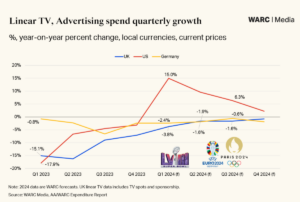Advertising to see sports boost but linear decline persists
Spending on TV advertising around sports will rise significantly this year, driven by the US and spending around the Paris Olympics, but this will not be enough to halt a longer term decline in linear TV ad spend, according to the WARC Global Advertising Trends: Sports media in the era of fragmentation report.
 According to WARC, global spending on sports media rights is forecast to reach US$60.9bn in 2024, citing SportsBusiness data, up 18.9% on pre pandemic levels.
According to WARC, global spending on sports media rights is forecast to reach US$60.9bn in 2024, citing SportsBusiness data, up 18.9% on pre pandemic levels.
Spending will be driven by the Summer Olympics and Paralympics, UEFA Euro 2024, and the T20 Cricket World Cup.
In the US brands are expected to spend an additional US$2 billion on the Paris Olympics while Euro 2024 will drive €250 million in incremental ad spend across Europe, according to the report.
However, WARC says that sport will not reverse declines in linear TV ad spend.
In the UK (-1.6%) and Germany (-0.6%), spend with linear TV is forecast to continue to decline throughout the summer of 2024. France, by exception will see growth of 4.9%.
In the US, a recovery of linear TV spend of 6.3% will owe more to year-on-year comparisons and the upcoming US Presidential election than to sport, says the outfit.
According to the report, 93% of 18-24s engage with sport on social media at least weekly, and 73% of those planning to watch Super Bowl LVIII on February 11 intend to watch the commercials.
Alex Brownsell, head of content, WARC Media, said: “Sport is one of the last providers of true ‘water cooler moments’, and this year’s bumper schedule of major sporting events, such as the summer Olympics and Paralympics in Paris, the UEFA European Football Championships, and the T20 Cricket World Cup, will provide advertisers with unrivalled means to achieve mass reach.
“However, these enduring qualities are under threat as consumption fragments. In this report we take a closer look at the current state of sport advertising at a time when media consumption poses a dilemma for brand advertisers.”



